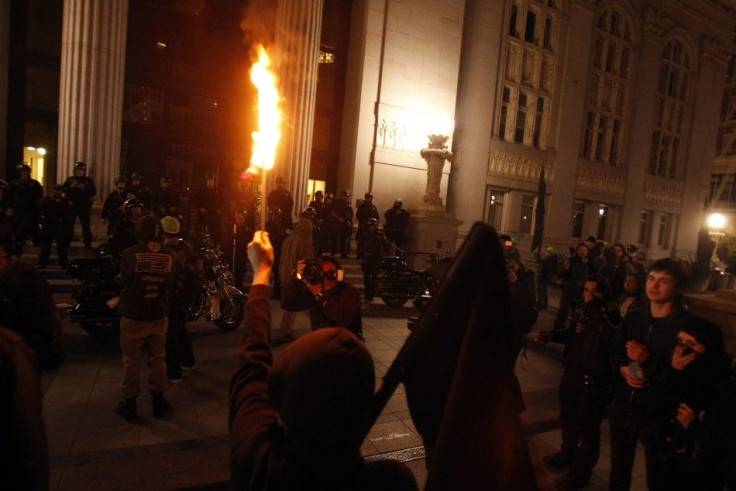Occupy Oakland Protests: Why They Keep Turning Violent

An Occupy Oakland protest once again spiraled into mass arrests and property destruction on Saturday, underscoring the city's reputation for hosting some of the most tumultuous and occasionally violent demonstrations of the Occupy movement.
That volatility reflects both the tactics used by Occupy Oakland and the Oakland Police Department's tendency to resort to heavy handed enforcement. Both of those factors appear to have been in play on Saturday.
Occupy Oakland Sees Violence As an Option
Occupy Oakland differs from its counterparts around the country in a few respects, perhaps most significanty its refusal to categorically renounce the use of violence. Salon's Joan Walsh described in November how a debate over the subject had fractured Occupy Oakland, with a substantial number of protesters endorsing a diversity of tactics that included property destruction. Walsh faulted the more black bloc faction for advocating violent tactics.
It is very much true. Occupy Oakland has been unable to get the thousands of people passing through Oscar Grant Plaza to agree to the principle of nonviolence, the protester L.E. Long wrote in response. Noting that there was no clear division between violence and nonviolence, Long said the lack of agreement reflected an effort to ensure Occupy Oakland was inclusive of everyone.
The acceptance of diversity of tactics is the acknowledgment that people will not now, nor ever agree as to what constitutes violence versus non, and that we must continue to work together in spite of this, Long wrote.
Tactics Antagonized Some Labor Leaders, Workers
The diversity of tactics approach also includes mass acts of civil disobedience. Occupy Oakland has twice shut down the city's ports, disrupting one of the country's largest commerce hubs. While protesters hailed the demonstrations as major successes, they also carried risks: violence and vandalism flared after the first shutdown, and the second one antagonized some workers and labor leaders, threatening to alienate an early ally of the Occupy movement.
At the same time, the Oakland Police Department has played a major role in escalating the prostests. A judge recently threatened the troubled police force with federal takeover unless it implemented reforms agreed to nine years ago in light of revelations that a group of officers known as the The Riders were terrorizing minorities.
This department finds itself woefully behind its peers around the state and nation, U.S. District Judge Thelton Henderson wrote in his ruling, adding that he remains in disbelief at the slow pace of reform. Henderson was reacting to a report by a specially appointed monitor that warned of serious concerns about how the police had handled the Occupy Oakland protests.
The police department faced heavy criticism for how police officers managed protesters after attempting to dismantle Occupy Oakland's Frank H. Ogawa Plaza encampment. In scenes resembling street battles, police officers fired tear gas canisters into the crowd, and an Iraq veteran sustained serious injuries after being struck in the head by a canister. Oakland mayor Jean Quan was excoriated, and some members of her administration resigned in protest.
Aggressive Police, Protesters Produced Saturday's Incident
That same combustile mix of civil disobedience, aggressive police officers and protesters willing to attack property exploded on Saturday. The protest was planned to take over the vacant Henry J. Kaiser Convention Center, and protesters had warned Quan in an open letter that attempts to bar them from doing so could result in indefinite occupation of Oakland's airport, port and City Hall.
Police repulsed protesters who tried to enter the convention center and later arrested hundreds of protesters who surged into a YMCA. A small group of protesters later entered City Hall, where they shattered glass, cut electrical wires and burned an American flag.
We're tired of one faction using Oakland as their playground, Quan said on Sunday.
But protesters blamed the police for a disproportionate response. Multiple news outlets reported that riot gear-clad police officers deployed tear gas and flash-bang grenades, and several journalists were unlawfully arrested. Protesters said that police did not give them time to disperse before beginning to arrest people.
Contrary to their own policy, the OPD gave no option of leaving or instruction on how to depart, the Occupy Oakland media working group said in a news release. These arrests are completely illegal, and this will probably result in another class action lawsuit against the OPD, who have already cost Oakland $58 million in lawsuits over the past 10 years.
--
© Copyright IBTimes 2024. All rights reserved.





















